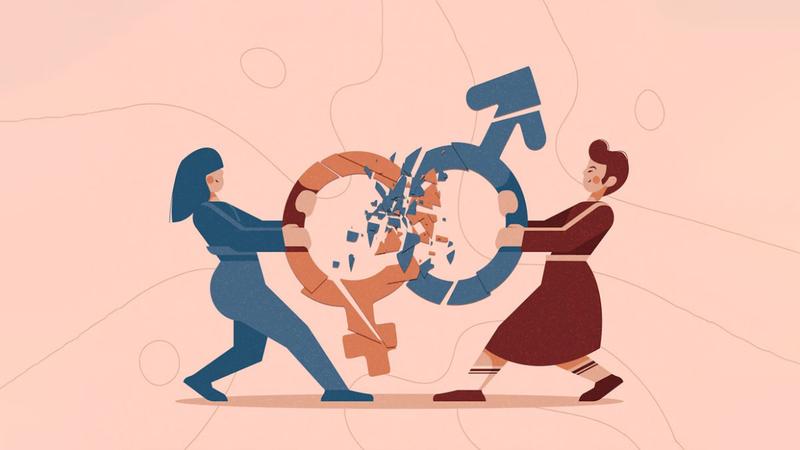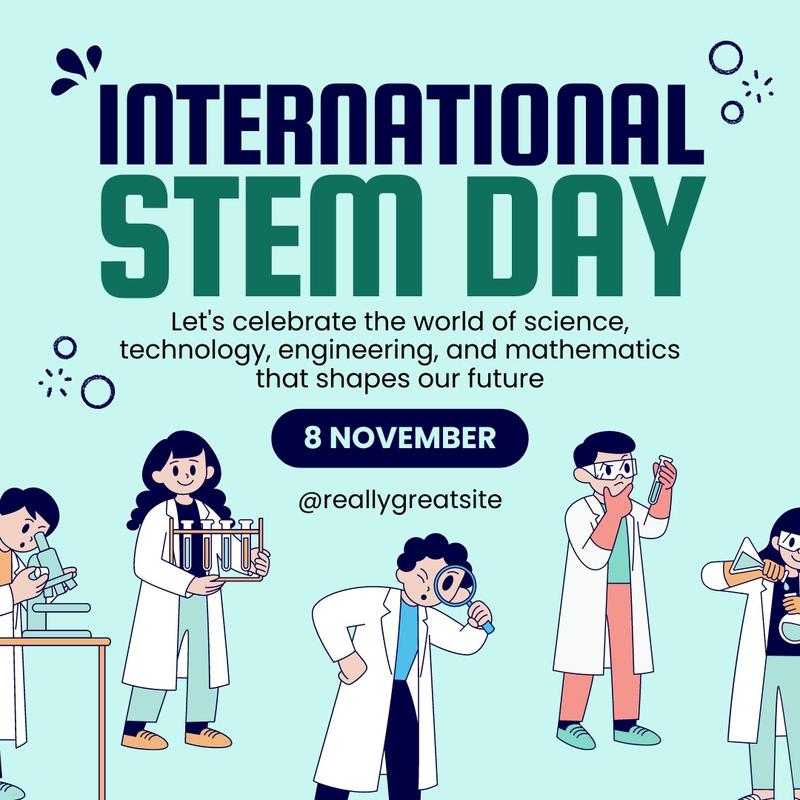Module 2
The importance of gender balance in STEM jobs
Module description
“Don’t let anyone rob you of your imagination, your creativity, or your curiosity. It’s your place in the world; it’s your life. Go on and do all you can with it, and make it the life you want to live.” – Mae Jemison, first African American woman astronaut in space.
The acronym STEM (from Science, Technology, Engineering and Mathematics) was used in the early 1990s by a variety of educators, including Charles E. Vela, the founder and director of the Center for the Advancement of Hispanics in Science and Engineering Education (CAHSEE). Traditionally STEM fields have been dominated by men, with a small number of women. What is the situation today and what are the reasons behind it?
This module is designed to shed light on the status of women’s involvement in STEM fields within Europe. We will take a look at why gender balance is important for all actors on the labour market and also beneficial for the economy.
In this module you will gain an overview of the barriers, societal stereotypes and biases women might face when entering STEM sector. You will also gain valuable insight on best workplace practises and initiatives to foster gender balance in STEM, including mentorship programs available to women. We will also be taking a look at various accomplishments and contributions by women working in STEM sector.
Learning outcomes of the module:
In terms of knowledge:
- You will gain a deeper understanding on barriers women face in entering STEM sector
- You will be able to identify strategies for women to enter and succeed in STEM sector
- You will gain insight on best practices in companies and mentoring programmes
- You will understand the benefits of gender balance to economy, companies and individuals
In terms of skills:
- You will be able to identify barriers women face in STEM education and employability
- You will be able to identify mentoring programs for women.
- You will develop your abilities to check for possibilities for a successful career in STEM
In terms of attitudes:
- You will refine your abilities to recognize gender stereotypes and biases
The current situation of women on the STEM market in the European Union

Source: https://www.enago.com/academy/empowering-women-in-stem-2023/
The acronym STEM (from Science, Technology, Engineering and Mathematics) was used in the early 1990s by a variety of educators, including Charles E. Vela, the founder and director of the Center for the Advancement of Hispanics in Science and Engineering Education (CAHSEE). Since the beginning those fields were dominated by men, with small number of women. What is the situation today?
The term STEM is used in the context of education policy or curriculum choices in schools. It is important for workforce development, national security concerns (as a shortage of STEM-educated citizens can reduce effectiveness in this area), and immigration policy, with regard to admitting foreign students and tech workers (Gonzalez & Kuenzi, 2012). According to the United Nations Office for Outer Space Affairs (UNOOSA), 90% of future jobs need skills related to STEM, a field with increasing contemporary influence on society.
Before we focus on a specific part of the STEM sector, we should look at the general outline of the situation.
In the European Union, more women than men complete higher education, so some might ask why we need projects like Future Women. However, the gender distribution in individual fields of study is not equal, based on Eurostat data from 2023. Women constitute the vast majority of fields related to education (79%).
Health and social care (72%) as well as social sciences and humanities (65%).
At the same time, in engineering they constituted only 27% and in communication and information technologies only 20%.
This is important because we are on the verge of a cultural crisis - technologies are playing an increasingly important role, which will significantly change the labour market in the near future. STEM professions will become more desirable and, therefore, better paid.
According to forecasts, some professions will experience significant growth by 2032. The most interesting (and best paid) offers include:
Computer and Information Researcher
According to Forbes, the increase in employment in this profession may reach up to 32%.
These employees are responsible for the development, design, and implementation of innovations in information technology. Knowledge of new programming languages and the basics of robotics will be a big advantage. The most developing fields are expected to be business and medicine.
Epidemiologist
The Covid epidemic has significantly increased awareness of how dangerous infectious diseases can be for both people and the economy. Epidemiologists will find employment in both the public and private sectors. Their main task is to study disease patterns and how they spread, but also to implement health care programs.
Data Analyst
The expected increase in employment is as much as 35%.
The main task is to collect, catalogue and analyse data using specialized tools and techniques. Information has long become a kind of currency, which is why analysts will be in demand in most sectors.
Market Analyst/marketing specialist
Wherever there is money, there is always employment. In the current market, giants are the most important, and trade itself is increasingly moving online.
A market analyst mainly collects data and analyses which marketing strategies bring the best results.
Programmer
Nowadays, virtually every gadget requires specialized software - no matter whether it's a vehicle or a smart refrigerator. Smartphone apps also make up a large part of the market. This trend is not likely to change - hence the expected increase of 26%.
Statistics specialist
A Statistics specialist, also known as a Statistician, is a professional who analyzes numerical data to identify trends and patterns. These insights help inform planning and decision-making processes in an organization.
Database architect
As you can see, many of the professions on this list are related to information. And it must be stored somewhere and protected against potential leaks. The increase in employment in this profession is a logical consequence.
Even though the media is currently threatening that AI will take away the jobs of most middle-level employees - including programmers, analysts, etc. There's really no reason to worry. Currently, this technology is too unreliable to replace humans, especially in responsible positions, and it is doubtful that this trend will change. Don't be afraid to invest in your future and education.
We have already outlined the directions in which the STEM market is expected to develop. So let's outline the current situation of women in this area. The situation varies in individual countries. Even though "on average" in the European Union, women are underrepresented in STEM, there are countries where they constitute the majority of engineers and scientists. There are also fields, for example biology, where women have been the majority since the 1970s.
The most female scientists and engineers are in Lithuania -52%. In Denmark, Bulgaria, Portugal and Latvia they constitute 51%. The lowest rates can be found in Finland - 31%. In Hungary 33% and in Italy 34%. When it comes to individual sectors, in services, women scientists and engineers constitute 46% of employees. In the aviation sector they constitute of 28%. The smallest percentage, only 8%, works in the water transport sector.
When it comes to roles in typical technology and IT companies, 46% of women are employed in product design and management. However, they are missing in positions closely related to calculations - they constitute only 15% and in DevOps - 8%.
Mapping gender balance in STEM

As incredible as it may seem to us, in the 1960s, women made up only 1% of scientists in STEM. Fortunately, the percentage of women is gradually increasing, and initiatives are being implemented to award additional points to female applicants during the selection process at certain universities - thus, the imbalances are not a consequence of preference.
So why are women less likely to choose STEM studies?
The following key factors are cited as the most common causes:
Gender stereotypes, repeated not only by teachers, but also by parents themselves, telling girls that they cannot think logically and that if they are to study something, they should choose humanities. Such specific programming of the mind from an early age not only cuts one's wings, but also constitutes a kind of self-fulfilling prophecy. The smaller representation of women in STEM means that there are fewer women who could break this stereotype.
Lack of cultural role models, there are few examples of women scientists in books, films, and pop culture in general. And it is culture that largely shapes us and gives direction to our ambitions.
Fear of science, The assumptions we make change our perception of reality. The stereotype that women cannot cope with science may cause teachers to evaluate students' work worse, to lose patience more quickly when explaining the issue, and as a result, to cause aversion to the subject.
Male-dominated environment, another factor that drives the vicious circle. Let's assume that the previous problems did not break the passion for STEM subjects and the talented woman would like to start studying computer science. The concern here may be the fact that the environment is dominated by men, which may make her feel alien in it or may seem unattractive to her.
Unequal distribution of responsibilities, in many countries, gender roles are still stereotyped, which translates into family responsibilities. Women are traditionally delegated to take care of children, regardless of whether they are their own offspring or siblings. They also develop a sense of duty. According to the 2022 report of the National Science Center in Poland, most female scientists express fear that parental leave will definitely slow down their careers, and they also feel a sense of guilt for neglecting family responsibilities.
Just because women are underrepresented in the STEM field doesn't mean they don't have significant achievements or contributions. Let's take a closer look at some silhouettes that may serve as inspiration:
Katalin Kariko, born in 1955 in Szelonek, Hungary - currently operating in the United States. She conducted research on nRNA for BioNTech, which was the first company to invent vaccines against COVID-19. Two of the vaccines were based on her research.
· Grace Hopper – American pioneer of computer science, who lived from 1906 to 1992. Doctor of mathematics and US Navy rear admiral. She collaborated on the creation of the first programming languages and also created the first compiler-program for automatic code translation.
Mea Jamison, born in 1956, American astronaut, doctor and chemical engineer. She participated in the STS-47 mission in 1992. The mission was intended to conduct experiments on the development of hornets in a state of weightlessness.
Hedy Lammar, born in 1914 in Vienna into a banker's family. She started her career as an actress. Being married into the third richest family in Austria, she met Nazi officials, including A. Hitler and Mussolini, and having had enough of these sick views spreading across Europe, she moved to the United States, where she continued her acting career - but there also began a period in which she contributed for science. During World War II, together with a friend, she developed a torpedo controlled by radio waves - but due to the lack of appropriate technology, the torpedo on her patent was only introduced in the 1960s. She died in 2000.
Rosalind Franklin, born in 1920, died in 1958, British biophysicist. She contributed to the improvement of X-ray equipment and is the co-discoverer of the DNA double helix. In 1953, she abandoned DNA research to pursue virology. She paid a high price for her scientific career - exposure to radiation contributed to the development of cancer, which ultimately caused her death.
Maria Skłodowska Curie, born in 1867, died in 1934, a scientist of Polish origin. She received the Nobel Prize twice - in 1903 for physics and in 1911 for chemistry. She developed the theory of radioactivity, isotope separation techniques, discovered two radioactive elements - Radium and Polonium, and was also a pioneer of radiotherapy.
Note that most of the great people mentioned come from a time when science was typically male-dominated. Today, the world of science is even more open to you.
Unfortunately, simply completing a STEM degree does not make gender-based problems end. Stereotypes make work difficult even when you are already employed. According to surveys conducted for the book Bias Interrupted: Creating Inclusion for Real and for Good, two-thirds of women declared that they constantly had to prove their self-worth and their scientific achievements were questioned.
Additionally, the work environment requires that women scientists be feminine, but paradoxically, their stereotypically feminine behavior - according to their male colleagues - causes them to be considered incompetent. So it requires constant attention and a balancing act between being masculine enough to be considered competent - and at the same time feminine enough to be liked by colleagues.
Of course, not everyone believes in stereotypes. Not every stereotype is negative either. An interesting study/mapping of stereotypes was performed by Merryn McKinnon and Christine O'Connel in the article Perceptions of stereotypes applied to women who publicly communicate their STEM work. Short phrases related to stereotypes were entered on the sheets and grouped into appropriate categories. Then, it was checked how often a given phrase appears in surveys. However, it turned out that some stereotypes were not clear when discussing them, it turned out that some of the stereotypes were not clear - for example, the stereotype that female scientists are nice/polite was perceived as both a positive and a negative feature - and what is more, these proportions were distributed similarly. There were also stereotypes that were mostly perceived as positive - Women in STEM are also perceived as Effective, Empathetic and more Collaborative.
The negative stereotypes included the following words: passive, bitchy, bossy, overestimated, too ambitious, aggressive, talkative. And here everyone will notice that some of the negative stereotypes have nothing to do with each other, and are even mutually exclusive.
The aim of the study was to reveal double standards - most of them were negative, but at the same time they were often mutually exclusive. Stereotypes depend on perception and as such are highly subjective and therefore unreliable. Additionally, neither gender is free from them - so it is worth paying attention to how you perceive yourself - and whether your thinking is free from stereotypes.
The importance of gender balance in STEM

Source : Canva
- Gender balance in STEM sector is very crucial simply because women and girls represent half of the world's population which means half of the world's potential.
- Diversity of thought: Women bring unique perspectives and approaches to problem-solving, leading to more innovative and inclusive solutions.
- Closing the gender gap: Increased participation of women in STEM fields is crucial for tapping into the full potential of our workforce and driving economic growth.
- Role models and inspiration: Seeing successful women in STEM careers empowers girls to pursue their own interests in these fields.
Importance of gender balance in STEM jobs for economies.
- Increase in labour supply.
- Increase access for women to well-paid employment sector in STEM and IT.
- Increase of sustainable development and reducing poverty.
- Foster diversity and inclusion, leading to more innovative solutions.
- Help address the skills gap in the STEM workforce, leading to economic growth and job creation.
Importance of gender balance in STEM jobs for companies.
- Access to larger number of skilled employees.
- Improved research, reducing gender bias in sciences so scientific studies can represent perspective of both genders.
- Improved products and services that can meet needs all the whole society.
- Social progress, creating more just and equitable society.
- Improved the corporate culture of companies.
The Importance of gender balance in STEM jobs for women.
- Increase in employment and productivity of women.
- Reducing the gender bias and stereotypes.
- Increase of confidence in girls within families to creating incentives for women to pursue career in STEM.
- Access to innovative and well paid sector.
- More role models and mentors for other women in STEM sector.
- High professional satisfaction.
It is crucial to ensure equal gender opportunities in professional activity and career development and it is now one of the main trends in the discussion concerning economic development. We live in world of increasing productivity, innovation, competitiveness and ecological changes. It is important to social potential equally, because it allows good use of the abilities and talents of employees of both genders on the market.
The European Commission has issued the document "Gender Equality Strategy 2020-2025". Gender equality has been defined as a core value of the EU and necessary factor for innovation, competitiveness and good condition of the European economy. It is crucial to incorporate gender perspective in digital, demographic and ecological changes.
Best workplace practices and initiatives to foster gender balance in STEM.

Source : Canva
Women encounter social and cultural obstacles hindering their progression and attainment of senior positions and leadership roles across various professional sectors, notably within STEM. Strategies to address this issue aim to foster gender equality and empower women to maximize their potential in these fields. Encouraging and supporting young women to pursue STEM careers is critical for ensuring a diverse and future-proof workforce.
- Encouragement and education: Providing early encouragement and educational opportunities for girls is crucial. This involves showcasing female role models who have excelled in STEM, as well as promoting educational programs tailored to these areas.
- Establishment of support networks: Creating supportive networks for women within the STEM community is vital. These networks offer assistance, guidance, networking platforms, and opportunities for mutual learning and growth.
- Advocacy for equality policies: Implementing policies that advocate for gender equality within STEM is paramount. These policies may include initiatives to enhance female representation in STEM sectors, financial support programs, and the advancement of equality in education and research.
- Combatting stereotypes: Educating and raising awareness about gender stereotypes and biases in STEM can help mitigate the impact of the glass ceiling effect. This entails promoting critical thinking, embracing diversity, and fostering equality in both educational settings and society as a whole.
- Offering internship and apprenticeship opportunities: Practical experience within organizations exposes girls to real-world applications of STEM and fosters career aspirations.
- Creating flexible work arrangements: Supporting work-life balance through flexible schedules and remote work options can attract and retain talented women in the workforce.
Best practices in STEM companies in hiring women.
Today, companies in STEM sector seek candidates with STEM education and skills. At the same time, companies are in very difficult situation to achieve gender balance.
We would like to present some companies who believe that women are important in STEM and create good examples of recruiting and retaining women in technical positions.
1. Nokia company has elaborated long-term plans concerning gender balance and promotes women in STEM in many ways. The company understands that improving the situation of women in STEM requires long term actions and commitment.
“Nokia is executing on a five-year strategy on gender balance, empowered by our leaders’ conviction and actions,” said Mohamed Habib, Resourcing and Employment at Nokia. “Awareness is a first major step. We have been taking it very seriously, training our leaders, managers and employees on gender balance best practices.”
Since 2016, Nokia has trained 4,200 leaders and employees on gender balance.
Nokia has also signed a letter of cooperation with UNESCO committing to promote gender equality, women’s empowerment and women’s leadership. Additionally, the company cooperated with Greenlight For Girls to inspire girls and young women in Science and Technology.
2. Autodesk company represents an excellent example how to eliminate bias in the hiring process. Implicit bias during employment process is very often embedded in work position descriptions, questions during interview and interviewer attitudes. Nowadays, companies should pay attention to job descriptions adverts as masculine-sounding words would have a negative impact on encouraging female applicants to apply.
Autodesk good practices in ensuring inclusive working environment include:
- Inclusive language in work position description.
- Building a culture of belonging where all employees have equal opportunities to succeed and contribute.
- Cooperate with NGOs which promote equal opportunities.
- Offer mentorship programmes to encourage and empower all employees.
- Support work-life balance by providing flexible working hours, remote work options, parental leave, and childcare assistance. This creates more inclusive and supportive environment for all employees.
3. 3M, manufacturing company 3M main goal is inclusion. In order to engage their employees, especially the female ones, the company offers resource networks such as the Women’s Leadership Forum, which “strengthen leadership skills and enhance collaboration across cultures, lifestyles and genders,” workplace flexibility policies, mentoring and mentoring and community engagement programs.
Strategies to foster interest and confidence in women to choose STEM studies.
Poland: initiatives of the Educational Foundation
Perspectives: “Girls as Engineers!" and “Girls go Science!".
Since 2013 in both initiatives over 150,000 women have participated. The main aim of “Girls as Engineers!” and “Girls go Science!” is to introduce technical and engineering studies to female high school students and to promote this educational path as interesting, attractive and very beneficial in the long run. It is also to show that technical studies address a recognized need of business and industry to attract highly trained workers with a variety of skills.
Website: https://dziewczynynapolitechniki.pl/english
Italy: annual Digital Girls summer camp, organized by, among others,
University of Modena, University of Bologna, European Women Management
Development Association. The camp has been organized since 2018 and participation is required free.
Website: https://ragazzedigitali.it/
Initiatives supporting women's scientific careers in STEM
Poland: annual conference organized by the Perspektywy Educational Foundation:
Women in Tech Summit. Since 2019, it has participated in conferences under this banner
participation of over 6 thousand participants from 52 countries.
Website: https://womenintechsummit.pl/
Germany: national pact for STEM - an initiative of the Ministry of Education and Research, bringing together over 250 partners from the science and business sectors. It is also an online platform
presenting information and interviews with women about their roles and activities in the field of STEM sciences and publishing guides with information
addressed to students and academic staff.
Website: https://graduatewomen.org/
Initiatives supporting innovative activities of women
Poland: mentoring and training program Girls go start-up! Academy. The organizers of this initiative are the Perspektywy Educational Foundation and the TOP500-Innovators Association. The program is addressed to female students, PhD students and graduates of technical and scientific fields. Its aim is to support women in acquiring knowledge and skills in creating start-up enterprises and implementing such ventures in practice. In the first edition of the program, 18 start-ups were established.
Website: https://www.girls-startup.pl/
Denmark: In 2018, the Innovation Fund launched four initiatives aimed at improving the gender balance among applicants for funding for their projects. The Fund's strategy takes into account the gender perspective in the application process, and its priority is to increase the share of women among applicants.
There are also many other initiatives across the world, which only shows how important gender balance has become to national and global economies.
Quizzes
External resources
https://eige.europa.eu/sites/default/files/documents/2017.2082_mh0217177enn_pdfweb_20170803123353.pdf - Economic benefits of gender equality in the EU.
https://eige.europa.eu/sites/default/files/documents/20182510_mh0218556enn_pdf.pdf - Study in the EU: set apart by gender.
https://euneighbourseast.eu/young-european-ambassadors/blog/stem-matters-ensuring-gender-balance-for-a-better-society/ - Article: STEM matters: ensuring gender balance for a better society.
https://magazine.swe.org/gender-balance/ - Article: Mapping Gender Balance in STEM Internationally.
https://knowhow.distrelec.com/pl/stem-i-edukacja/kobiety-w-naukach-stem-w-unii-europejskiej/ - Article: Kobiety w naukach STEM w Unii Europejskiej.
https://www.copernicus.eu/en/news/news/observer-women-copernicus-together-towards-better-world - Article: OBSERVER: Women & Copernicus: together towards a better world.
https://www.linkedin.com/pulse/lets-talk-immediate-value-stem-education-erin-carmody/ - Article: Let's Talk About the Immediate Value of STEM Education.
https://www.weforum.org/publications/global-gender-gap-report-2023/ - Global Gender Gap Report 2023.
https://www.europarl.europa.eu/doceo/document/A-9-2021-0163_EN.html - REPORT on promoting gender equality in science, technology, engineering and mathematics (STEM) education and careers.
Gonzalez & Kuenzi, 2012: Science, Technology, Engineering, and Mathematics (STEM) Education: A Primer